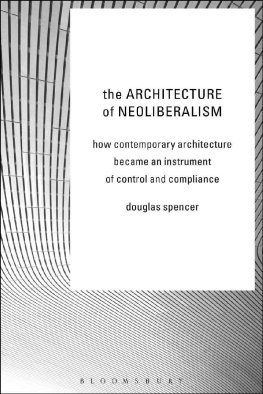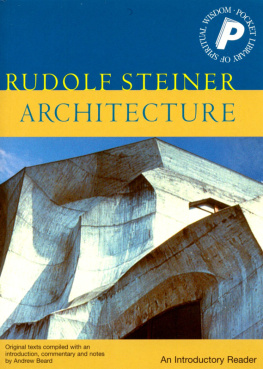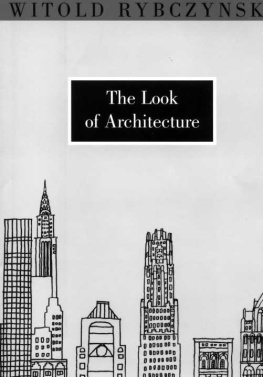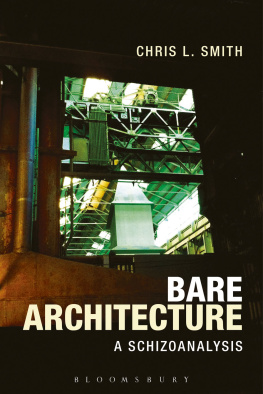The Architecture of Neoliberalism
For Becky,
a continuing source of inspiration
The Architecture of Neoliberalism
How Contemporary Architecture Became an Instrument of Control and Compliance
Douglas Spencer
Bloomsbury Academic
An imprint of Bloomsbury Publishing Plc

Contents
Greg Lynn FORM, Korean Presbyterian Church of New York, 1999, photo: the author, 2006
NOX Lars Spuybroek, Maison Folie, Lille, France 20014, photo: the author, 2004.
Zaha Hadid Architects, London Aquatics Centre, London, 200511, photo: the author, 2014.
Foreign Office Architects, South-East Coastal Park, Barcelona, 2004, photo: the author, 2005.
Zaha Hadid Architects, Galaxy Soho, Beijing, 200912, photo: Shengze Chen, 2012.
Zaha Hadid Architects, exterior, Central Building, BMW Leipzig, 20015, photo: the author, 2009.
Zaha Hadid Architects, interior open structure, Central Building, BMW Leipzig, 20015, photo: the author, 2009.
Zaha Hadid Architects, radial cornering patterns, Central Building, BMW Leipzig, 20015, photo: the author, 2009.
Zaha Hadid Architects, main entrance, Central Building, BMW Leipzig, 20015, photo: the author, 2009.
Zaha Hadid Architects, exterior panelling, Central Building, BMW Leipzig, 20015, photo: the author, 2009.
OMA/Rem Koolhaas, construction, CCTV Headquarters, Beijing, 200212, photo: Ana Abram, 2008.
OMA/Rem Koolhaas, construction detail, CCTV Headquarters, Beijing, 200212, photo: Ana Abram, 2008.
OMA/Rem Koolhaas, exterior, CCTV Headquarters, Beijing, 200212, photo: the author, 2011.
OMA/Rem Koolhaas, exterior with advertisement, CCTV Headquarters, Beijing, 200212, photo: the author, 2011.
Richard Rogers and Renzo Piano, Pompidou Centre, Paris, 19726, photo: Savia Palate, 2011
Foreign Office Architects, Meydan Retail Complex, Istanbul, Turkey, 20057, photo: Murray Fraser, 2012.
Foreign Office Architects, Meydan Retail Complex, Istanbul, Turkey, 20057, photo: Murray Fraser, 2012.
Morphosis, New Academic Building, Cooper Union, New York City, 20069, photo: Manuel Shvartzberg, 2015.
Morphosis, New Academic Building, Cooper Union, New York City, 20069, photo: Manuel Shvartzberg, 2015.
Foreign Office Architects, Ravensbourne College, London, 2010, photo: the author, 2010.
Foreign Office Architects, Ravensbourne College, London, 2010, photo: the author, 2010.
Foreign Office Architects, Ravensbourne College, London, 2010, photo: the author, 2010.
AZPML, Birmingham New Street Station, Birmingham, 201015, photo: the author, 2015.
Future Systems, Selfridges Department Store, Birmingham, 2003, photo: the author, 2015.
Mecanoo, Library of Birmingham, Birmingham, 200813, photo: the author, 2015.
NOX Lars Spuybroek, Maison Folie, Lille, France 20014, photo: the author, 2004.
Crispin Wride, John Lewis Building, Stratford, London 2011, photo: the author, 2015.
This work is the result of research and writing undertaken over a number of years. During that time I have had the opportunity to discuss this work with a number of people whose criticisms, comments, encouragement and support have proved invaluable to its development and realization. These include Tanis Hinchcliffe, Andrew Higgott, Ross Adams, Ivonne Santoyo-Orozco, Camilo Amaral, Libero Andreotti, Eva Castro, Alfredo Ramirez, Clara Oloriz Sanjuan, Tim Waterman, Ed Wall, Jon Goodbun, Marina Lathouri, Manuel Shvartzberg, Alexendra Vougia, Platon Issaias, Jack Self, Don Rawson, Helen Beesley and the students of MA History and Critical Thinking at the Architectural Association from 2012 to 2015. Thanks to Ana Abram, Savia Palate and Shengze Chen for the photographs. Thanks to James Thompson at Bloomsbury for his enthusiasm and support for this project, and for his patience. Special thanks are due to Nadir Lahiji and Ben Noys for taking the time to read and comment on draft chapters of the book. My most sincere gratitude and greatest respect are due to Murray Fraser and David Cunningham for the part they have played in standing up for, and nurturing and refining, my research with their tireless efforts and invaluable insights.
This book originated in a critique of what I have called, elsewhere, Deleuzism in architecture. I was concerned, in this, with challenging the appropriation, by certain architects and architectural theorists, of the conceptual vocabulary of Deleuze and Guattari in order to present themselves as the advanced guard of a new and emancipatory direction for architecture. These claims were contested through close readings of the written discourse of this architectural Deleuzism, and through an analysis of its built projects that showed how these were, rather than liberatory, in fact instrumental to a neoliberal agenda of subjectification. This critique, and its methods, remains central to this book. Rather than focusing only upon the appropriation of the thought of Deleuze and Guattari, however, I also consider other factors through which architectural discourse and practice has rendered its services to neoliberalism as instruments of control and compliance. I address the development of a post-critical and projective position in architecture, and the refashioning and repurposing of architectural theory through which this was accomplished. The uptake of universal models of self-organization, complexity and emergence in architecture is also reflected upon, particularly in light of their role in the construction of neoliberalisms own truth games. The more recent turn to theories of affect in architectural discourse and its affirmations of an unmediated and post-linguistic experience of the built environment are also critically contested here.
In calling to account the claims of what Jeff Kipnis once designated as the new architecture, I have turned, as well, to a mode of analysis through which the development of both neoliberalism and the architectural positions that effectively further its causes can be understood in historical terms. To this end I have drawn upon an earlier period of theorizing, particularly where this was concerned, in certain works by Jean Baudrillard, Jean-Franois Lyotard and, especially, Michel Foucault, with what was at stake in the new modes of power whose outlines had first emerged in the 1970s. I have also returned to the thought of the so-called Frankfurt School, particularly that of Theodor Adorno, in order to mobilize his critique of affirmation and his perspectives on conceptual thought, experience, perception, aesthetics and mediation in relation to the latest turns within late capitalism.
I have tried, as well, to understand and represent here how neoliberalism operates as productive of models and means of power and control, particularly in relation to what I refer to, following Foucault, as the production of subjectivity. Rather than presenting neoliberalism simply as some unrestrained, extreme expression of the essential and unchanging nature of capitalism, I have sought to comprehend it as a school of economic thought that has consciously directed itself, through key individual thinkers, as a project to remake the mentality and behaviour of the subject in its own image, as in accord, that is, with a totalizing logic of economically opportunistic valorization. Foucaults lectures on the Birth of Biopolitics have been fundamental to this task, as has the writing of those who have, more recently, responded to and built upon these, such as Christian Laval and Pierre Dardot, and Philip Mirowski. In addition to these secondary accounts of neoliberal thought, I have also addressed certain of its key texts directly, especially those written by its chief intellectual theorist, Friedrich Hayek. Through the analysis of these I have outlined some of the arguments through which the central tenets of neoliberalism have been contrived, particularly those concerning spontaneous orders, self-organization, complexity and cybernetics upon which much contemporary architecture also now grounds its own principles and practices.
Next page










